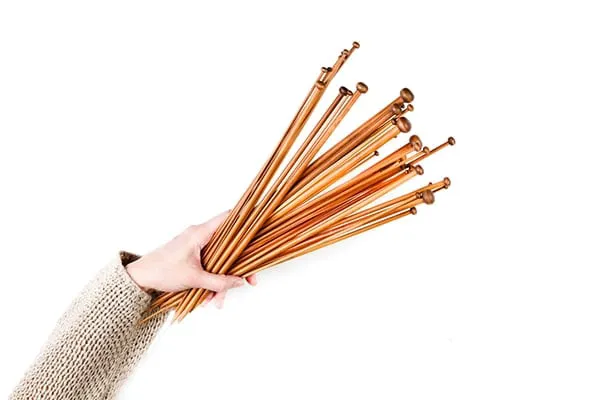Basic Knitting Tools: Essential Equipment for Beginners
Get Started with Knitting: A Guide to the Basic Tools You Need
Get Started with Knitting: A Guide to the Basic Tools You Need
Acrylic Yarn
Every knitter has their own favorite type of yarn. Our go-to yarn for beginners is acrylic because it’s inexpensive, accessible, and durable. The best part about acrylic yarn is that it’s easy to wash! Other yarns might need special care, like handwashing, but most projects made with acrylic yarns can be tossed into the washer and dryer. This makes it perfect for home decor projects like afghans or throws that are large and need to be cleaned often.
We recommend starting with a bulky, chunky, or jumbo yarn as you learn to knit! Chunkier yarns make it easy to see the stitches. You’ll also find that thick yarn gives stitch patterns a more pronounced texture. It’s easier to see progress as well.
Start To Create…
If you have the simple tools you need to get started, then nothing is stopping you from creating your first swatches.
Then moving on to your first knitting project.
I hope you have enjoyed this list and if you think I have missed anything, please let me know in the comments below.
View tutorials on my YouTube channel
Knitting Lessons
If you are new to knitting and need help with the basics, check out more free how-to resources here: Knitting Lessons (With Video Tutorials).
There, you will find step-by-step tutorials for all the different knitting techniques a newbie needs to know.
This includes how to cast on, how to bind off, how to knit the basic stitches, how to knit the knit stitch, how to knit the purl stitches, and how to knit the rib stitch pattern.
How to make the mattress stitch, short rows, yarn over(yo), knit the slip stitch, use the magic loop technique, how to decrease knitting, how to change yarn colors and more.
Also included is a list of knitting abbreviations (UK + US terms), a knitting needle size guide, and more
Essential Knitting Supplies
Without further ado, here are the 7 most important knitting tools that every beginning knitter should have.
Knitting Needles
The knitting journey starts with needles. There are several types:
- Straight Needles: Ideal for beginners, straight needles are great for flat pieces like scarves or dishcloths. A US 8 (5mm) is a good starting point. As for materials, we recommend wooden or bamboo needles because of their grip (so you don’t have to stress about your stitches sliding off.)
- Circular Needles:These needles are connected by a flexible cable, so you can knit round pieces like hats. They’re also really useful for larger projects like blankets that might be too big to handle on straight needles. As a beginner, you might not need these right away, but they’re worth exploring as you progress.
- Double Pointed Needles (DPNs):These come in handy for small, circular projects, like socks or the tops of hats. They’re a little trickier to manage at first, but not too difficult once you get the hang of them.
To learn more about needles, check out this handy Knitting Needle Sizes Chart.
Yarn
And of course, you’ll need some yarn. We recommend starting with a medium-weight yarn, often labeled as a “Category 4” or “worsted weight” yarn. Choose a smooth texture and a lighter color so it will be easy to see your stitches (and fix those inevitable mistakes.)
To learn more about what type of yarn to choose, take a look at our Yarn Weight Chart.
Scissors
A good pair of sharp, sturdy scissors is essential for cutting yarn. Any pair will do, but most knitters like to keep a small pair in their knitting project bag.
Tapestry Needle
A tapestry needle is a large-eyed blunt needle that you’ll use to weave in the yarn ends at the end of your project. Choose from straight-tip or bent-tip needles, depending on your preference.
Stitch Markers
Stitch markers are small metal or plastic rings that you’ll use to mark important stitches in your project. They’ll help you keep track of where you are in your pattern, making sure you don’t miss any important instructions.
Gauge Ruler
A gauge ruler is a small square ruler that you can use to measure your swatches and calculate your knitting gauge. Getting the right knitting gauge is essential if you want your finished project to fit!



Tegs:
Search
Recent Posts
-
Quilling for Beginners: Master the Art of Quilling with These Simple Techniques
Apr 19 2025
-
Mastering the Art of Macrame: A Comprehensive Knot Guide
Apr 21 2025
-
Get Started with Knitting: Choosing the Right Basic Knitting Needles for You
Apr 24 2025
-
Find the Perfect Sewing Machine for Beginners: A Guide to Essential Features and Top Recommendations
Apr 27 2025
Subscribe to Updates
Get the latest posts and fashion insights directly in your inbox.